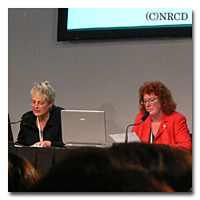IT-training for visually impaired persons
VIETNAMPROJEKTET (Tunis)
LOTTA

Ladies and gentlemen! Good morning!
-My name is Lotta Stegmar
-And mine is Maud Hedblom.
We are going to present the project, ICT training for the visually impaired in Vietnam, which was carried out at the end of spring this year. It concerned education of visually impaired in Vietnam.
Before we go on we want to introduce ourselves.
We come from Sweden and are working as ICT-tutors for blind and partially sighted persons. The name of our company is Iris Hadar.
We teach disabled persons how to use different help programs together with ordinary applications used at work. That's why we were assigned to go to Vietnam and implement this project.
Together with us we also had a technician.
As you know ICT(information and communication technologies) is widely used in society today and it is of vital importance for the visually impaired to take part in this development and to get ICT training.
With good ICT knowledge the individual gains independence.
This is the reason for the project, which was initiated by the Swedish and Vietnamese organizations for visually impaired, that is SRF in Sweden and VBA in Vietnam.
The project was financed by SIDA and involved the Swedish and the Vietnamese governments.
Here you see a picture of the participants in the project ICT Training for the Visually Impaired in Vietnam.
The concrete plan for the project was to go to Hanoi and during 8 weeks teach 20 Vietnamese students how to handle a computer as a visually impaired.
12 persons in the group were blind, the rest were sighted. 8 were women and 12 were men. Most of them were between 20 and 30 years old.
Iris Hadar is working with the concept of "train-the-trainer". The aim is to build competence that will stay in the country and continue to increase and spread long after we have left.
The most important thing was that we had to prepare these students to be teachers themselves, to be resource teachers for visually impaired. They must be able to teach how to use a computer, how to work with common applications together with help programs for the visually impaired.
Most of the participants of the group had very low level of English, so we had to work with an interpreter and we had to have our text books translated into Vietnamese.
After the course the equipment was handed out to 3 different cities in Vietnam and is now used in their own ICT-training courses.
We had a syllabus where the 8 weeks were roughly planned. The students had to learn the basics of Windows, Word, Outlook and Internet together with different help programs like screen readers and magnification programs. They also should have experience of Braille displays and Braille embossers.
Methods
We are going to tell you about our teaching methods.
- Lesson by teacher, we had lessons in front of the class
- Individual work at their own computers
- Reflexions and discussions about the methods
- Training lessons of each student
- Technical education for some of the students
- Evaluations, weekly from students and teachers
- EMT, Education Management Tool, our company's special tool for making sites at Internet
2 Most of the time the students worked individually with self instructive text books and exercises produced by us.
The students had all the text books in Braille, on paper and on file, so they can use it later, when they are out working as resource teachers. The text material was in English but also translated into Vietnamese.
3 The discussions were a very important part of the education. We wanted each student to reflect on the teaching methods for visually impaired and come up with new ideas.
So the reflexions of the blind students were especially important for the group to hear.
4a All of the students had at least one lesson in front of the other students to practice being a teacher.
4b Afterwards the students discussed and criticized the presentation.
4c The students also practiced being teachers by helping each other.
5a Five of the students, two of them were blind women, learned more about technical matters.
5b They must know how to take care of the hardware, how to install and customize the help programs, how to give support when something is wrong with the computer etc.
LOTTA
6 Every week each student wrote down his or her reflexions about the training course.
The course material was evaluated. After the course the students got a CD with all text books and exercises in English and Vietnamese.
7 On Internet we used a tool called EMT and thanks to this tool we could document the project while it was going on. The project owners could follow it while it was happening.
On this site we had, among other things, the syllabus, presentations of the students and the staff, pictures from daily life of the course. Here we also published all evaluations of the students and staff.
But since the majority of the group had a low level of English we got help by a Vietnamese translator.
On Fridays we had a more relaxed afternoon, when we learned about similarities and differences between Sweden and Vietnam. We sang songs and talked about our two countries.
We also presented some Swedish games which they got as presents at the end of the course.
According to students' evaluations the project was a success. Today we know that 3 out of 4 cities have their own training courses running.
Right now a technician from our company and members from SRF in Sweden are in Vietnam to follow up the project and discuss a continuation.
If you want to know more about the project you can find us at the exhibition-case, ICT 4everybody. Nr
